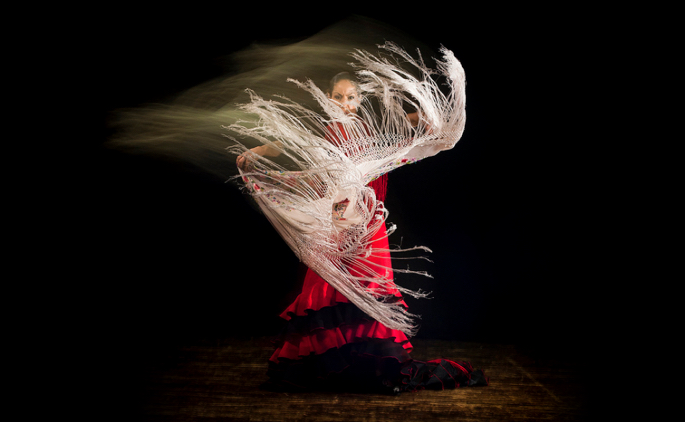Solea is arguably one of the most basic palos in flamenco. This cante grande form probably originated around Cádiz or Seville in Andalusia and is usually accompanied by a single guitar. The letras of solea are generally serious in nature, as appropriate to the stately solemnity of the music.
Solea usually played por medio (on the sixth string in E phyrgian, relative to the capo) and at a slow tempo – commonly around 90 beats per minute. Solea performance also often involves rubato, the expressive speeding up and slowing down of tempo at the discretion of the performer.
The compas of solea emphasizes the 3, 6, 8, 10, and 12 beats:
1 2 3 4 5 6 7 8 9 10 11 12
Solea is sometimes called “mother of palos.” Though it is not the oldest (siguiriyas is older), there are a number of palos that derive their compas from solea include solea por buleria, the palos in the cantiñas group, like alegria, romera, mirabra, caracoles and, to a certain extent, buleria.
Basic Solea Rhythm
This is the basic solea rhythm in E phrygian, played by Curro Montoya of flamencoeduca.com. The basic pattern moves between just E and F, relative to the capo on the first fret. The guitarist uses the underlying compas and chord voicing, phrasing, timing, passing notes, and embellishment to make this simple patter musically interesting.
Solea Stylistic Variations
Solea probably evolved from the dance form jaleo in the late 18th century and has since taken on distinct characteristics from different regions, cities, and individuals. Solea on the guitar traces its origins to the caña and palo forms, which predate it, but are less commonly performed today. In all of its varieties, solea embodies a solemn, cante jondo (deep song) character.
El Chalo: Romani Tradition
Traditionally, flamenco traces its origins to the Romani ethnic groups of Andalucia. Many flamencos with Romani roots continue to embrace these traditions and keep them alive thriving. El Chalo, performing in the Albaicín, one of the oldest centers of Muslim culture in Granada, provides an excellent example.
This brief intro shows how with (mostly) two chords and a healthy dose of embellishement, there is a lot you can do with solea.
Pepe Habichuela: Solea in Concert
Solea is also a popular solo piece for concert performers, where an arrangement will include a complex development of ideas across falsetas and progressions. Even in these very detailed and precise modern arrangements, however, you can still hear solea’s basic themes and compas resonating throughout.
Accompanying Dancers
As dance accompaniment, a solea arrangement includes specific sections that allow the dancer a range of expression and interpretation. In addition to a guitar introduction that sets the mood of the piece and the falsetas that develop it melodically, a guitarist will also want to include passages for subitas (builds), escobillas (standardized passages of footwork), and remates (dramatic finishing moments).
To learn more about the individual parts of solea dance accompaniment in detail and learn how to put them together in a full arrangement, check out the Solea Accompaniment article here on Ravenna Flamenco.

